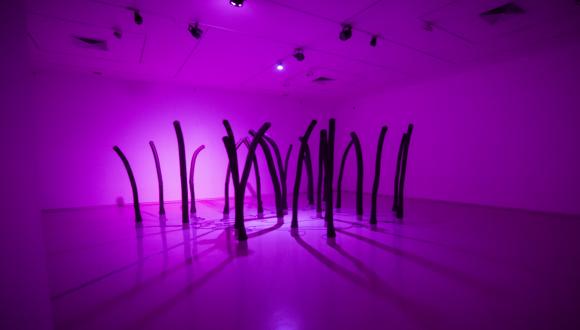Tropism
Tropism
Liat Segal and Dr. Yasmine Meroz
We have before us a field of robotic “plants,” which traces the characteristics and behaviors of real plants. The artist Liat Segal, known for her sophisticated use of technology, has created giant stalks that respond to changing light in the gallery space. Similar to plants in nature, their motion follows the light and adapts as it changes. The stalks are coated with carbon fibers, a material which incorporates both organic and artificial qualities, imparting to the stalks a futuristic feeling. Their motion is based on scientific data from the research of Dr. Yasmine Meroz, who studies plants’ memory and decision making – research being conducted as part of the GrowBot project, with financing by the European Union.
This innovative collaboration between an artist and a scientist has subverted the common notions we hold about plants. In medicine, the state called “vegetable” indicates a loss of consciousness, thought, recognition, and ability to absorb information from the surroundings. This approach can be traced to Aristotle’s claim that plants lack comprehension, senses, and motion. But today we know that all this is untrue: plants respond to external stimuli and even respond with movement. The work before us makes us aware of them as rational beings, capable of learning, solving problems, and making decisions – beings with complex comprehension and behavior which is not human, but not necessarily inferior to that of humans.
”Tropism,” directional movement in response to external stimuli, challenges the familiar hierarchy between nature and humanity. In the strange, surrealistic world that Segal has created, the plants have grown to human proportions and move about at human speed. The mechanical soundtrack of their movements stands in opposition to plants’ calm, balanced behavior in nature. This is a work which asks the viewer to consider changes that take place over time, in the artificial sunrises and sunsets that illuminate the gallery and the stalks’ reaction to them. Natural plants, rooted in the ground, act as an integral element of a wide net of species – allies and rivals. Even though plants compete for resources, they do not fight with species that are stronger than them, and they know how to establish an optimal balance between their need for survival and their need to protect their immediate environment. In this sense we, human beings, have a great deal to learn from plants about the equilibrium required for a sustainable way of life.
Liat Segal
Tropism
2020
Site-specific installation, electronics, mechanics, software, cement, iron, carbon fibers
Courtesy of the artist


